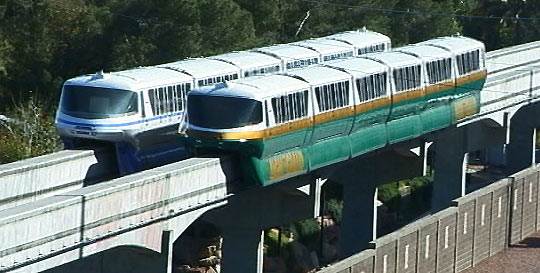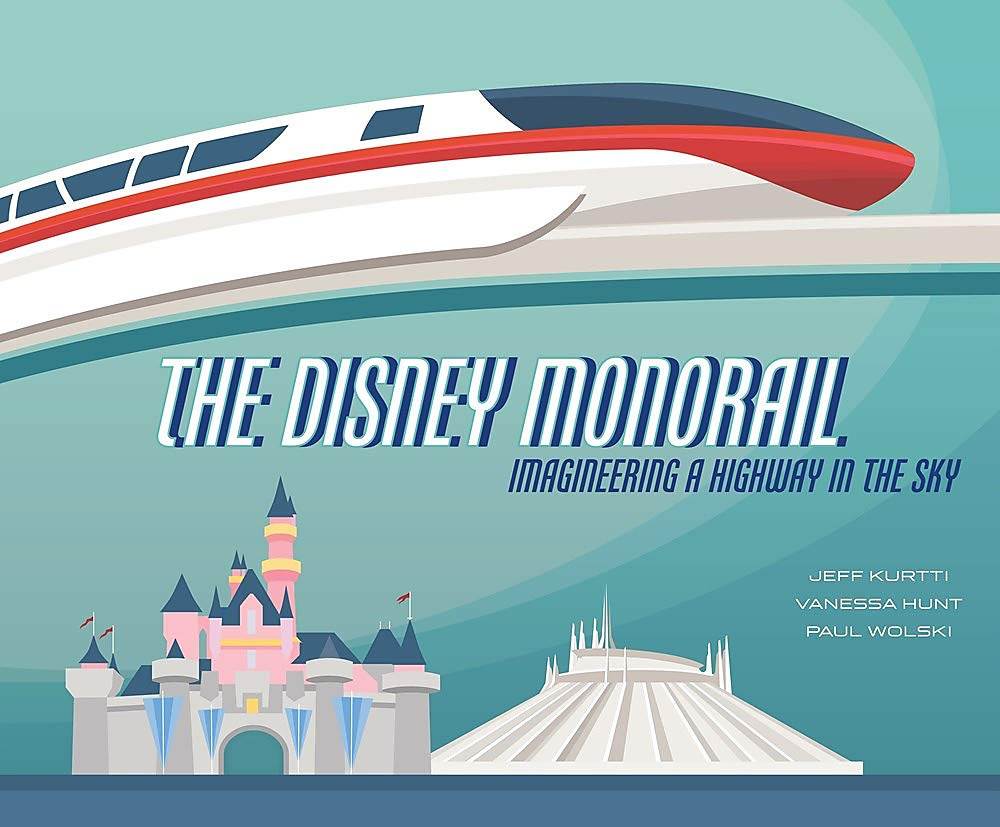Book Review: “The Disney Monorail: Imagineering a Highway in the Sky”
“Please stand clear of the doors. Por favor manténgase alejado de las puertas.” That memorable safety spiel from the monorails in operation at Disneyland and Walt Disney World has become iconic, inspiring souvenirs from shirts and hats to car magnets and keychains. There’s something special about gliding in an elevated train aboard a singular beam and it's an experience that most North American residents primarily know thanks to Disney. Now Disney fans can take a trip through the history of the “Highway in the sky” via a new book from Disney Press called The Disney Monorail, co-authored by Jeff Kurtti and Imagineers Vanessa Hunt and Paul Wolski.
The title and size of this coffee table book are a little misleading. It’s fairly light on copy, heavy on photos, and only two-thirds is truly about Disney monorails. Out of 208 pages, the titular “Disney Monorail” doesn’t become a focal point of the narrative until page 70 (If you don’t count the foreword by Tricia Nixon Cox and Julie Nixon Eisenhower, which is the highlight of the book). Chapters leading up to this moment document the development of Disneyland’s Tomorrowland, a history of monorails and worldwide attempts at building them, and Walt Disney’s futurist ideology. The images are great, with concept art from legendary Disney Imagineers and photos from the history of the parks, but I feel like I have most of the concept art already collected in previous books, including Kurrtti’s own The Art of Disneyland and The Art of Walt Disney World. However, it is esthetically pleasing with nice design work.
The title of The Disney Monorail also calls to mind a Muppet*Vision 3D joke that Sam Eagle says when describing the finale: “It’s a salute to all nations, but mostly America.” In that same spirit, this book is a salute to all monorails, but mostly Disneyland’s. Disney World fans will likely be disappointed that only pages 138 through 171 cover the third most utilized monorail in the world and number one in the United States. That’s 33 pages, mostly in pictures, to cover Walt Disney’s dream of monorails as a real mode of transportation in its most realized form at a Disney destination (Not counting Japan, where nine other monorail systems run outside of the Tokyo Disneyland Resort, making it less of a novelty experience). There’s some conversation about Walt Disney’s plans for EPCOT, but not a lot of context, making it even more confusing that so much time is spent on the creation of the original Tomorrowland, yet Walt Disney’s city of the future where automobiles were forced underground and surface level transportation was exclusive to Monorail and Peoplemover is excluded. I was wondering why the title of the book is singular and it might as well have been called “The Disneyland Monorail” for how much it glosses over the rest.
Another confusing creative choice is the fact that the authors chose to tell the Disneyland Monorail story with no breaks, covering Mark I, II, III, then V, and then VII before taking you through the Disney World Mark IV and VI later. It wouldn’t be a big deal, except they tell you that the Disneyland Mark V took its design queue from Disney World’s Mark IV before ever showing readers what they’re talking about. Even a 2-page spread highlighting the differences between each model comes after that reveal, making readers who weren’t already aware of this have to work to piece it together. In that regard, the authors are really speaking to a very specific audience: A Disney Parks aficionado who already knows a great deal about the history of Disney Parks. If you fall into that category already, then reading this book is likely unnecessary because nearly all of the information is harvested from previously published sources that you might already own. Despite the fact that Disney will likely stock this book at theme park gift shops, the average Guest looking for more information about monorails was seemingly absent from the authors’ minds as they assume they know things that most visitors to Disney’s vacation kingdom’s aren’t familiar with.
The Disney Monorail: Imagineering a Highway in the Sky has received a lot of buzz for the last page of the book, which features a concept poster for a monorail-themed experience planned for the EPCOT Play Pavilion. But make no mistake, the book is entirely focused on the past without any look ahead at the future, save for that lone image with no explanation. It strikes an odd parallel between the main narrative of Walt Disney, the forward-thinking futurist, without mentioning that aspect of his legacy being carried forward by the present Walt Disney Company, which would’ve been a much more uplifting ending than the one I’ll cover in the next paragraph.
The book has three very uncomfortable moments. One is a page devoted to monorail safety systems at Walt Disney World, which goes from a paragraph about the greatness of the original safety systems to a single sentence blurb about upgrades installed in 2014. Elsewhere, a spread about the types of monorails and their colors lists pink and purple as retiring in 2009 with peach and teal being introduced in 2011 to replace them, the only other allusion to the 2009 monorail crash that ended in tragedy. For the record, they never mention Disneyland Monorail safety systems, so if they didn’t want to skirt around the topic, why include these three paragraphs at all? There’s also no mention of safety systems for the Tokyo Disneyland Resort’s monorail either. Another unsettling aspect is the way the authors call out every Disney monorail replacement as being required due to wear and tear on the previous fleet, when most of them were in service for much shorter periods of time than the currently operating Disney World Mark VI fleet (as made obvious on that same 2-page chart highlighting their differences). It’s not hard to read between the lines at the commentary they’re making without saying a single word. Lastly, the book ends with a groan-worthy pat-on-the-back epilogue. The authors interview themselves about unknown Disney Artist Paul Hartley, quoting themselves as if they were each interviewed by the other when at least one of them had to have written this. After congratulating themselves for making you aware of Hartley, they give you a dossier that ends with the artist’s suicide. That’s the last thing you’ll read before you close the book. Other dossiers on a handful of key contributors to Disney Monorails are embedded earlier in the book and moving this one anywhere but the end would’ve been less of a downer.
The Disney Monorail: Imagineering a Highway in the Sky by Jeff Kurtti, Vanessa Hunt, and Paul Wolski feels like a great idea that was transferred to the wrong beam of track. I wanted to love it and it’s just full of reasons to not recommend it to fellow Disney fans. For one final example of the lack of care with the subject, the fate of some of the Disney World Mark IV trains is included as a single sentence about the Las Vegas monorail system in the “Global Monorails Today” section. Those trains have since been replaced, but given their origin and with a huge white space on the same page, any reader would want to see a picture of them in operation on the historic Las Vegas strip. This is a fun bit of Disney history that a lot of Disney fans don’t know about and the authors buried the information in a seemingly non-Disney section rather than including it with the rest of the Mark IV content. Since the authors didn’t bother to include a picture of these Disney Monorails with a Las Vegas paint job, here’s one courtesy of monorails.org. That same resource can also give you a lot of the non-Disney monorail history that’s regurgitated in this book.

Photo Source: Monorails.org
My recommendation: Skip The Disney Monorail unless you just want it for the pictures and for a better book about Walt Disney’s forward-thinking ideas, pick up Don Hahn’s Yesterday’s Tomorrow: Disney’s Magical Mid-Century.

